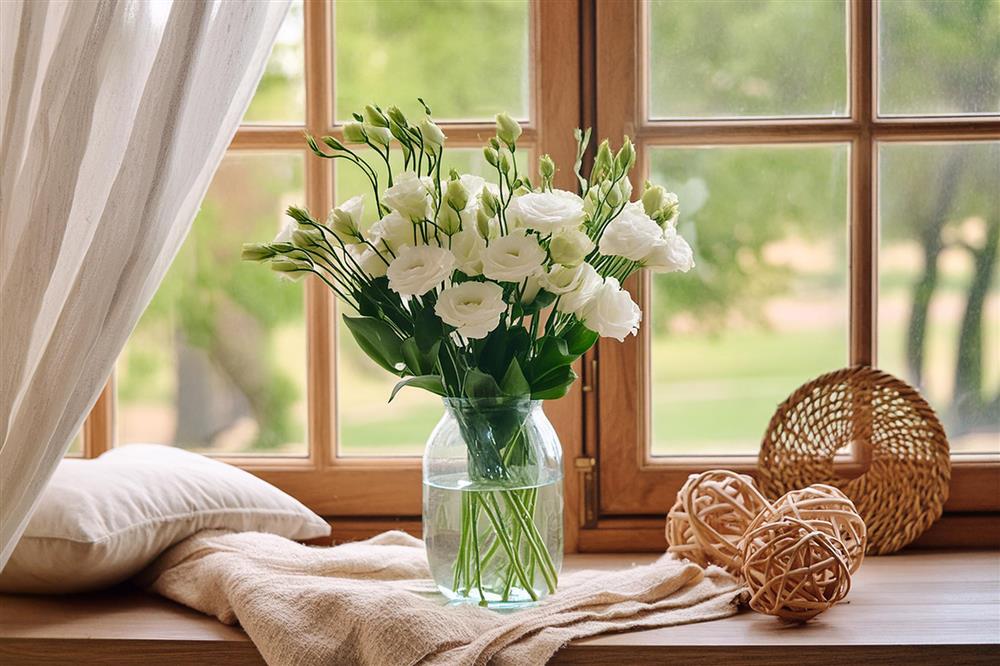This is the story of lisianthus, a flower admired for its unique petals and rich history. Whether you’re passionate about home décor, love to travel, or simply appreciate flowers, lisianthus brings a blend of beauty and meaning. In this blog post, we talk about the origins and significance of this stunning flower and find out why it’s cherished by florists and flower enthusiasts alike.

Historical Background
Lisianthus, also known as Eustoma, originates from the prairies of North America, particularly in regions such as Texas, Nebraska, and Colorado. Historically, these flowers were admired for their ornamental value.
As explorers and settlers moved westward, they were captivated by the unique beauty of lisianthus, which eventually made its way to Europe and gained popularity among gardeners and florists.
The European gardeners were charmed by its rose-like appearance and long-lasting flowers, making it a sought-after addition to gardens and floral arrangements.
Cultural Significance
Throughout history, lisianthus has carried a variety of meanings and symbolism. In the language of flowers, it often represents appreciation, gratitude, and charisma.
Its delicate, ruffled petals are seen as a symbol of love and respect, making it a popular choice for weddings and other significant events.
In modern times, lisianthus continues to be a symbol of sophistication and refinement. It is frequently used in bridal bouquets, centrepieces, and decorative displays at high-profile events and celebrations.
Its versatility and lasting beauty make it a favourite among florists and flower enthusiasts.
Varieties and Colours
Lisianthus comes in a range of stunning varieties and colours, each with its own charm.
Common colours include white, pink, purple, and blue, with many bicolored and ruffled varieties adding to their allure.
Here’s what some of the colours symbolise:
• White Lisianthus: Purity, innocence, and sympathy.
• Pink Lisianthus: Romance, admiration, and joy.
• Purple Lisianthus: Royalty, success, and beauty.
• Blue Lisianthus: Calmness, tranquillity, and inspiration.
These colours can be used to convey specific messages in floral arrangements, making lisianthus a versatile choice for various occasions.
Growing and Caring for Lisianthus
If you’re a gardening enthusiast or simply love having fresh flowers at home, growing lisianthus can be a rewarding experience. Here are some tips to help you get started:
• Planting: Lisianthus prefers well-drained soil and plenty of sunlight. Plant the seeds indoors about 10-12 weeks before the last frost date, then transplant them outdoors when the weather warms up.
• Watering: Keep the soil consistently moist but not waterlogged. Lisianthus enjoys regular watering, especially during dry spells.
• Fertilizing: Use a balanced fertilizer to promote healthy growth and vibrant flowers. Fertilize every 4-6 weeks during the growing season.
• Cut Flower Care: To extend the life of cut lisianthus flowers, trim the stems at an angle and place them in fresh water with a floral preservative. Change the water every few days to keep them looking their best.
Incorporating Lisianthus into Your Home and Events
Lisianthus is a versatile flower that can accentuate the beauty of any setting. Here are some ideas to inspire you:
• Home Décor: Add a touch of charm to your home by arranging lisianthus in vases or decorative containers. Their soft, pastel hues blend beautifully with various interior styles.
• Weddings: Use lisianthus in bridal bouquets, boutonnieres, and centerpieces for a romantic and sophisticated look. Their long-lasting flowers make them ideal for wedding celebrations.
• Special Events: Incorporate lisianthus into floral displays for parties, anniversaries, and other special occasions. Their graceful appearance and variety of colours make them perfect for creating memorable arrangements.
Fun Facts and Trivia
Despite its delicate look, lisianthus is a hardy flower that can last up to two weeks in a vase with proper care. Additionally, lisianthus flowers can symbolise appreciation and gratitude, making them a thoughtful gift for loved ones.
From its rich history and cultural significance to its diverse varieties and practical uses, lisianthus is a flower that exudes elegance and reliability.
Whether you’re decorating your home, planning a wedding, or simply enjoying the beauty of flowers, lisianthus offers endless possibilities.
Explore our collection of lisianthus and other wholesale flowers at www.flowersuppliers.co.uk and bring a touch of floral charm into your life.

Royal Horticultural Society (RHS). "Growing and Caring for Lisianthus." Retrieved from RHS
Missouri Botanical Garden. "Lisianthus (Eustoma grandiflorum) Plant Profile." Retrieved from Missouri Botanical Garden
Florists' Review. "Trends and Techniques in Floral Design." Retrieved from Florists' Review
Flower Magazine. "Floral Design and Décor Ideas." Retrieved from Flower Magazine
Harampolis, A., & Rizzo, J. (2013). The Flower Recipe Book. Artisan.
Benzakein, E. (2020). Floret Farm's A Year in Flowers: Designing Gorgeous Arrangements for Every Season. Chronicle Books.
University of Illinois Extension. "Gardening and Plant Care Resources." Retrieved from University of Illinois Extension
Cornell University Cooperative Extension. "Horticulture and Floriculture Resources." Retrieved from Cornell University Cooperative Extension
Teleflora. "Flower Symbolism and Meanings." Retrieved from Teleflora
Gardening Know How. "Growing and Caring for Lisianthus." Retrieved from Gardening Know How

